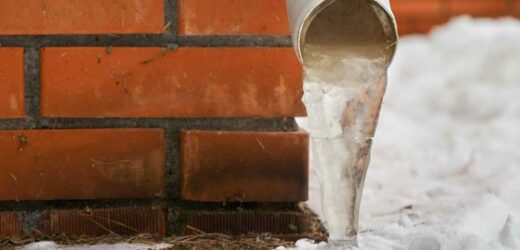WITH temperatures plummeting across Britain, many parts will be facing the headache of their water supply being affected by arctic conditions.
We look at what you can do prepare for the cold snap and the best way to address any problems you may encounter with frozen pipes.
Why do pipes burst?
When water freezes into ice, it expands, resulting in more volume in the pipes than when water is simply running through them.
The ice creates pressure inside the pipes which can in turn cause a rupture.
When water freezes, its molecules crystalize into an open hexagonal arrangement, which takes up more space than when the molecules are in their liquid form — that is, the water molecules expand as they freeze.
As the ice expands, it pushes liquid water toward the closed faucet.
This causes an immense amount of water pressure to build between the ice blockage and the faucet — eventually, the pipe ruptures under the pressure, usually at a spot where there's little or no ice.
The pipe segments upstream of that ice clog generally aren't in danger of bursting because the pressure isn't great enough.
In this case, the water isn't blocked, and can always retreat back to its source.
Pipes that are the most at risk of bursting are those that are exposed: located outside of building insulation, or in unheated interior areas like basements, attics and crawl spaces.
What can I do if my pipes freeze?
If you notice that one of your pipes maybe frozen, turn off your inside stop tap immediately.
It is usually located under the kitchen sink but can also be found in a number of other places from downstairs bathrooms, kitchen cupboards, garages, cellars and even under the stairs.
You will need to open all of your taps to drain the system as quickly as possible.
It is wise to save some water in a bucket, if you can, for flushing toilets and hand washing.
When the water finally stops running, turn off all of the taps.
An exposed frozen pipe can be thawed easily, but remember to start at the tap and work back towards the frozen area so trapped water can flow out.
You can use a hair dryer on a low setting to deal with the freeze, or try taking a portable heater to the problem area.
Holding a hot towel to the frozen area may also help, or you can pick up some specialist electrical heating tape to deal with the blockage.
However, you should NEVER try to thaw a frozen pipe with an open flame, since it could damage the pipe or start a fire in your home.
READ MORE ON NEWS
Family pay tribute to brothers, 6, & 10, who died with cousin, 11, in lake
31 dead & 20 left blind after drinkers open lethal batch of bootleg booze
Inside JFK assassination conspiracies as theorists speculate on unseen files
Inside the dark world of Miss America from disappearances to fat-shaming
How to prevent pipes from bursting?
If your heating isn’t working efficiently, the cold spots in your system will be most vulnerable to the cold.
Ensuring that your boiler is serviced annually, preferably in the warmer months, will prepare the pipes and system for everything that winter has in store.
Insulating your pipes and water tanks is one of the best ways to prevent them from freezing.
You can buy inexpensive pipe lagging and tank jackets from most DIY stores and them yourself for free.
Just make sure you check the pipe and tank measurements first.
You should focus on outside pipework, pipes in colder areas of your home and water tanks.
If you have pipes and tanks in unheated loft spaces, open the hatch during icy weather to allow the warm air from downstairs to rise and keep the chill off.
If some of your pipes or tanks are inside cupboards, open the cupboard doors so the air from warmer parts of your home can circulate around them.
When it’s frosty outside, you need to make sure it doesn’t get too cold inside to stop your pipes from freezing, it is recommended keeping your thermostat set to at least 7°C, even if you are not home.
How do you thaw pipes if they are underground or in a wall?
One of the easiest ways to thaw pipes in hard to reach places is to turn your thermostat up.
If the frozen blockage runs deeper in the pipe you may need to use an infrared lamp, place it close to the blocked portion and let the lamp melt the blockage and defrost the pipe.
In the instance of more serious problems, you may need to cut a section of the wall or floor out in order to thaw the frozen pipe more effectively.
Once you have managed to thaw the pipes, leave the faucet running for a few minutes.
This clears any leftover ice.
Once you’re sure there is no ice left, turn off the faucet.
If the problem is more complicated, call an emergency plumber.
Source: Read Full Article







